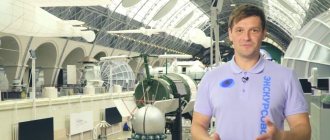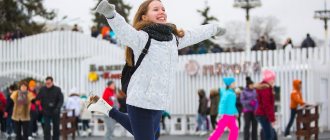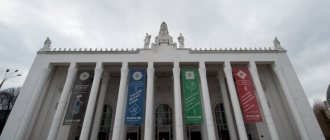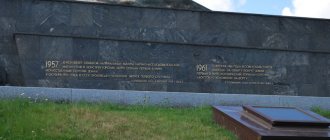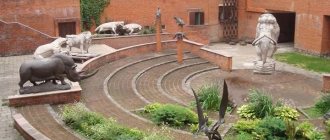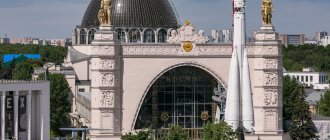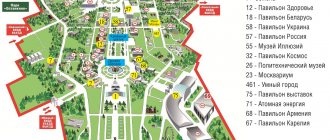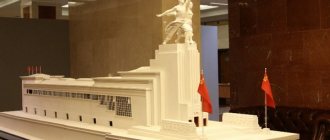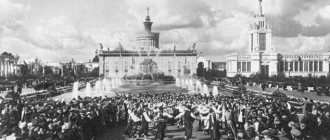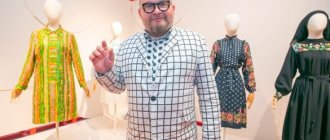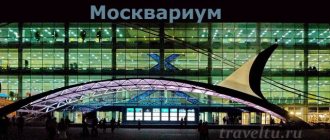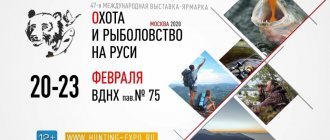Exhibition of architectural achievements of the Soviet era. Top 10 pavilions that are pleasing to the eye.
A city of dreams in a capital city. Fountains, alleys, sculptures. The exhibition of achievements of the national economy was opened on the occasion of the 20th anniversary of Soviet power.
The best architects took on the large-scale project. The task was set as a national one - to create a worthy frame for the achievements of the young country. The architectural frame of collective farmers' work changed from project to project. Over the years, Alexander Zhukov, Evgeniy Vuchetich, and Alexander Deineka worked on the facades.
Decades later, the buildings of this unique architectural complex are recognized as objects of cultural heritage, and VDNH is a landmark of the entire country. Let's learn the history of the pavilions together with Natalya Letnikova.
Pavilion No. 4 “Kyrgyzstan”
The intricate pattern with ears of corn attracted attention to the exhibition of achievements of the Estonian SSR for the first decade.
Architects H. Arman, A. Wolberg and N. Tarvas placed a majolica carpet and the coat of arms of the republic on the façade.
In the mid-60s, VDNKh exhibitions were divided by region. Pavilion No. 4 talked about biology. The exhibition, which was brought together by fifty scientific institutions in the country, plunged into the world of living nature. Today the building is the exhibition center of the Republic of Kyrgyzstan.
History of VDNH
1935–1941
The decision to build the All-Union Agricultural Exhibition (VSKhV) was made at the Second All-Union Congress of Collective Farmers-Shock Workers. It was supposed to open for the 20th anniversary of Soviet power for 100 days. The idea of the Exhibition was largely symbolic in nature. To prove the success of collective farm construction, it was decided to create abundance in the fenced area of Ostankino Park.
Construction began in the second half of 1935. Buildings from standard wooden parts were erected slowly. But by July 1937, the pavilions of Belarus, Ukraine, the general pavilion of the Transcaucasian republics, Tatarstan, Turkmenistan, mechanization, the Main Pavilion, the pavilion of beets, vegetables, etc. were already ready. The opening was postponed for a year, since it was not possible to make it in time for the anniversary of Soviet power. Temporary wooden pavilions, designed to last 100 days, were rebuilt so that they could stand for five years (later this period would be extended to infinity). At the same time, traces of modernism were eliminated. They again did not make it by the appointed date and announced a new opening date - August 1, 1939.
In July 1938, Vera Mukhina’s sculpture “Worker and Collective Farm Woman” was brought from the Expo-37 exhibition in Paris. In less than a month, the monument was installed on the driveway to the Main Entrance of the All-Russian Agricultural Exhibition. The sculpture, instead of the original 34-meter pavilion-pedestal, as in Paris, was installed on a 10-meter cube, which significantly distorted the overall architectural appearance of the monument.
Among the pavilions built by this time, some were reconstructed, improved, and supplemented with new architectural delights. Exhibition pavilions began to display the most characteristic features of the national style of each of the union republics, as well as regions of the RSFSR. A forgotten and inconspicuous wasteland on the north-eastern border of Moscow turned into a unique exhibition city, where 52 different pavilions and another 200 different buildings were presented on 136 hectares.
On August 1, 1939, the All-Union Agricultural Exhibition was finally inaugurated. The ceremony was attended by 10 thousand people, and in the first 85 days of the All-Russian Agricultural Exhibition, more than 3.5 million visitors saw it.
The exhibition has become a familiar vacation spot for Muscovites and tourists. It continued to operate virtually unchanged until the German invasion of the USSR.
1941–1945. The Great Patriotic War
On July 1, 1941, by order of the Council of People's Commissars of the USSR, the Exhibition was closed. All livestock presented by collective and state farms for display at the All-Russian Agricultural Exhibition was promptly exported. The rest - the unique collection of the VSKhV library, a darkroom and an archive - were evacuated to Chelyabinsk. The pavilions were mothballed. The only personnel left were people to guard and maintain the remaining exhibits. Other Exhibition employees went to the front. 127 of the 260 workers of the All-Union Agricultural Exhibition who joined the people's militia of the 13th Rostokinsky Division were killed. On July 10, 2021, a monument was unveiled at VDNKh in their honor.
The workshops of military repair plant No. 20 were located on the basis of the production and technical workshops of the All-Russian Agricultural Exhibition. In one day, up to 60 motorcycles for the front were assembled on its conveyors. During the Second World War, almost the entire housing stock of VSKhV was occupied by workers and employees of military-defense enterprises.
After the war
In 1948, the Council of Ministers decided to revive the All-Russian Agricultural Exhibition by 1950. But the reconstruction took not two years, but six. The opening took place only in 1954. By this time, the Exhibition area had grown to 207 hectares.
Several fountains appeared: “Friendship of Peoples”, “Stone Flower” and “Golden Ear”. A five-kilometer highway with trolleybus traffic was built. Most of the pavilions were rebuilt. The layout structure of the Exhibition has changed, so the Main Entrance has moved. The three-span triumphal arch, which used to be the Main Entrance, is now called the Northern Entrance. Architect Innokenty Melchakov built an even more monumental five-span triumphal arch as the new Main Entrance. The sculpture “Tractor Driver and Collective Farm Woman” was placed on top of the entrance arch, but instead of a hammer and sickle they held a large sheaf of ears of grain.
The main pavilion was completely rebuilt as a building with a spire. The pavilion of the Moscow, Ryazan and Tula regions was reconstructed according to the design of the architect D. Chechulin: the building acquired a more austere appearance, and the 52-meter tower reaching into the sky, crowned with a star, gave it lightness and sublimity.
By 1954, the pavilion “Ukrainian SSR” was crowned with a spire in the form of a golden sheaf to commemorate the 300th anniversary of the reunification of Ukraine with Russia. The Belarus Pavilion was demolished and a new one was built in its place, surrounded by an open colonnade and completed by a rotunda with the sculpture “Motherland”, which symbolizes gratitude to the soldiers of the Soviet Union for salvation in the Great Patriotic War.
The light, open, constructivist boathouse of the Mechanization pavilion was complemented by a domed hall and a heavy monumental facade.
1958–1967
In 1958, inspired by the Grand Prix for the architecture of the Soviet pavilion in Brussels, Nikita Khrushchev signed an agreement with Eisenhower on the exchange of exhibitions between the USSR and the USA.
The American exhibition in Moscow was supposed to take place from July 25, 1959 for six weeks. At the same time, a Soviet exhibition was planned at the New York Coliseum.
The agricultural exhibition, the purpose of which was to convince the population of the USSR of the success of collective farms, became an exhibition of consumer goods, initially addressed not so much to Muscovites as to US Vice President Richard Nixon. However, the Exhibition did not make an impression on him. Driving through VDNKh in an open limousine, he smiled and waved his hand in greeting. And then he sent Eisenhower a secret telegram that contained only two words: “Nothing outstanding.”
In 1963, the Council of Ministers adopted a resolution “On the restructuring of the work of VDNKh of the USSR.” The exhibition became year-round.
At this time, the very principle of display changed, agriculture gave way to science and industry. The pavilions named on a geographical basis have changed their names. Belarus became “Electrical Engineering”, Lithuania - “Chemistry”, Latvia - “Physics”, Moldova - “Standards”, Kazakhstan - “Metallurgy”, Armenia - “Healthcare”, Ukraine - “Agriculture”. Along the way, some pavilions were dressed in modernist clothes. Azerbaijan, for example, first became “Computer Engineering”, and then was decorated with stamped aluminum panels of approximately the same type that were previously updated in the “Radio Electronics” pavilion.
In 1966, a pavilion was built for the International Exhibition of Agricultural Machinery, which later became the Chemical Industry Exhibition. It was already a modern architectural structure, although not entirely original - critics noted the influence of the classic of modernism Mies van der Rohe.
In 1967, for the 50th anniversary of the October Revolution, the Consumer Goods Pavilion, also a modern and unoriginal building, was erected. In the same year, the Gas Industry pavilion appeared, containing an obvious reference to Le Corbusier’s famous masterpiece, the Ronchamp Chapel. The most noticeable addition to the modernist part of the Exhibition was the huge USSR pavilion, brought from the Montreal Exhibition of 1967 and mounted on the territory added to the Exhibition.
1970–1980
Every year the exhibitions acquired more and more interesting and impressive forms. Thousands of exhibits filled the new pavilions. In 1971, a Decree was issued by the Presidium of the Supreme Soviet of the USSR on awarding the Exhibition with the Order of the Red Banner. From now on, all official documents read “Order of the Red Banner of Labor Exhibition of Achievements of the National Economy of the USSR.”
In the seventies, one of the members of Brezhnev's Politburo visited Czechoslovakia. They brought him to the restaurant. There, color images were simultaneously projected onto a dozen movie screens: palm trees, the underwater world, and views of the Earth from space.
They reported what they saw to Brezhnev. The Secretary General demanded that something similar be built in Moscow, giving the new project a “bright socialist beginning.” The Central Pavilion at VDNKh was chosen as the location for the first Soviet multi-screen spectacle entitled “We are the Soviet People.” And the project was to be implemented by specialists from Czechoslovakia. In a fairly short period of time, several dozen automatic overhead projectors and a computer controlling them were installed in the round hall of the Central Pavilion. With the participation of Soviet ideological consultants, they wrote and approved a script with typical phrases and slogans of the announcer's text, collected thousands of negatives and slides in Moscow archives, completed additional filming and dubbed the film. Brezhnev also arrived at the premiere.
Significant events for the USSR and Moscow also took place during this period. VDNKh was chosen as the venue for them. These are the International Youth Festival, the exhibitions “Auto Industry”, “Scientific and Technical Progress” and “60 Years of Soviet Cinema”, the opening of the first oceanarium in the Union and others.
Foreign exhibitions held at VDNH attracted a huge number of visitors. And even though these were mainly expositions of socialist countries, they were also of great interest to the Soviet people.
1988–2013
In 1988, VDNKh was transferred to self-financing, and then completely lost state funding. We had to survive on our own and look for new sources of financial support.
The management decided to rent out pavilions and other useful space. Having received pavilions with live exhibitions for rent, some tenants immediately vacated the resulting “useful” space, turning them into points of sale of consumer goods and even warehouses. The expositions of the pavilions “(formerly “Uzbek SSR”) and others were destroyed. Even in the Zolotoy Kolos restaurant, which in Soviet times was considered one of the most prestigious along with Prague and Moscow, they organized a storage room.
In 1992, VDNKh of the USSR was renamed into the joint-stock company "GAO All-Russian Exhibition Center". Later, this era was popularly dubbed the “era of the All-Russian kebab house.”
By 1994, almost all exhibitions in the All-Russian Exhibition Center pavilions were closed, with the exception of the livestock industry pavilions. And even those were liquidated by the first half of the 2000s. Only the amusement park remained untouched then.
Some pavilions were never saved. In 2005, a fire destroyed an architectural monument - the Hunting and Fur Farming pavilion, and in 2011 the pavilion with unique paintings by V.A. also burned down. Favorsky "Veterinary medicine".
In the early 2000s, the leadership of the All-Russian Exhibition Center wanted changes. It was decided to develop an exhibition area. In 2009, in addition to three exhibition pavilions (No. 20, 57 and 69), multimedia pavilion No. 75 (MosExpo) was opened. It met all the modern requirements of an international exhibition complex. The pavilion became a center for international events and its own exhibition and congress projects, which demonstrated the latest technologies in the field of healthcare, innovation, energy and resource saving.
In parallel, international cooperation with the republics of the former Soviet Union began to develop. In the republican pavilions you could buy anything produced in these countries. In 2002, a decision was made by the Council of Heads of State of the CIS to create permanent exhibitions of the CIS member states on the basis of the All-Russian Exhibition Center. In 2010–2011, the Russian Government began concluding a number of intergovernmental agreements on the organization of trade and exhibition pavilions of the republics that accepted the invitation to cooperate on the territory of the complex.
Meanwhile, the Government of the Russian Federation - the main owner of the shares of OJSC "GAO All-Russian Exhibition Center" - and the Government of Moscow (the owner of a 30% stake) received dozens of proposals and concepts a year from private investors about what should be done on the Exhibition territory. Restoring the complex was not a priority. The projects included construction of up to 500,000 sq. m. m of residential real estate. As of November 2013, about 30% of the All-Russian Exhibition Center lands and facilities were already in private ownership.
Pavilion No. 51 “Meat Industry”
The central building of the livestock sector, where the main exhibits are artiodactyls.
Sculpture of N.A. Kongissera “Bull Fighter” towers on the pavilion, and the tribesmen of the powerful animal support the columns.
Architects V.M. Lisitsyn and S.G. Chernobay wove ancient Persian and Greek styles into the project. The exhibition introduced visitors to the latest developments in the meat industry both in theory and in practice - in a tasting room on an open terrace overlooking VDNKh.
VDNH today
The revival of VDNH began at the end of 2013, when Russian President Vladimir Putin handed over the unique exhibition complex to the Moscow Government. The revival project was headed by Moscow Mayor Sergei Sobyanin. On his initiative, a vote was announced to return the historical name of the Exhibition - VDNKh. The initiative was supported by 90% of participants.
In the spring of 2014, emergency work was carried out in the pavilions at VDNH - more than 50 historical pavilions and objects were saved from destruction, retail outlets were demolished and liquidated, and tons of garbage were removed. New lawns have been installed on an area of more than 125 hectares.
In 2015, new spaces opened - the Moskvarium Center for Oceanography and Marine Biology, the historical park "Russia - My History", an entertainment and educational park, "Robostation" and others.
In 2021, the Exhibition was replenished with the Smart City pavilion, and the Crafts Park opened.
In 2021, the second stage of revival began - large-scale reconstruction and improvement of the territory. The modernization of utility networks has been completed, more than 130 km of utility lines have been updated, and 20 km of new pipes have been laid. As part of the Clean Sky program, 26.9 km of wires are hidden underground.
By the summer of 2018, large-scale work on the improvement of the Central Alley was completed. Here the restored complex of 14 fountains in octagonal bowls lined with red granite began operating again. All work was carried out in strict accordance with the 1954 project.
Also significant events of 2021 were the appearance of the largest space museum complex in modern Russia - in the restored Cosmos pavilion, the Technograd educational and leisure complex, where you can master more than 40 specialties, the flagship Palace of State in the restored pavilion No. 71 "Atomic Energy" . The Golden Ear fountain was restored and launched for the first time in the last 30 years.
In 2021, the main exhibition of the country celebrated its 80th anniversary. During the anniversary season, more than 100 festive events were prepared for guests: festivals, concerts, exhibitions, as well as the opening after restoration of historical pavilions, new cultural, educational and sports spaces.
2019 has become a year of new discoveries. In January, the Fairy Tale Theater opened in the renovated pavilion No. 9 “Young Technicians”; in February, workshops and art residences of the Garage Museum were located in the specially converted building No. 317; in April, in pavilion No. 13 “Healthcare” (formerly “Armenian SSR”) The Museum of the East is open.
The celebration of the 80th anniversary of the Exhibition began on April 30 with the ceremonial launch of the “Friendship of Peoples” and “Stone Flower” fountains, which appeared before the guests in all their splendor after the first comprehensive restoration in 65 years. They remain the calling cards of VDNKh and Moscow and favorite meeting points for Exhibition visitors.
In May, in the restored pavilion No. 58 "Agriculture" (formerly "Ukrainian SSR"), a modern museum, educational and educational platform of international level - the Center for Slavic Literature "Slovo" - opened. Its exhibition is dedicated to the history, present and future of Cyrillic writing.
On the day of the 80th anniversary of the Exhibition—August 1—the VDNKh Museum opened in the right wing of the Main Entrance. In it you can find out how the Main Exhibition of the country was created and worked over different eras, how its ensemble was formed and the content changed.
On the eve of City Day, an educational and methodological workshop was opened in pavilion No. 25 “Oil”. Its new exhibition, respecting continuity, was dedicated to the history and modern achievements of one of the leading sectors of the domestic economy.
By the fall of 2021, 20 out of 49 cultural heritage sites have been restored. In 14 of them, comprehensive scientific restoration has been completed: this is the arch of the Northern entrance, pavilions No. 13 “Healthcare” (former “Armenian SSR”), No. 34 “Space”, No. 58 “Agriculture” (former “Ukrainian SSR”), No. 18 “ Byelorussian SSR", No. 62 "Nature Conservation", No. 84 "House of Culture", No. 71 "Atomic Energy", fountains "Golden Ear", "Friendship of Peoples", "Stone Flower" and a complex of 14 fountains of the Central Alley, monument B .AND. Lenin and the system of flower stalls.
Pavilion No. 67 “Karelia”
The bog oak façade is not lost against the background of the Stalinist Empire style. One of the smallest pavilions at VDNKh changed its name almost immediately after the completion of the work by architects F.I. Rekhmukov and A.Ya. Reznichenko: The Karelo-Finnish SSR became simply Karelia.
The golden letters against the background of the rich carving of the pediment are still preserved. The displays ranged from arts and crafts to Soviet printing and even the winter residence of Father Frost. After all, the pavilion itself is like a tower - in the best traditions of peasant houses of the Russian North.
Six interesting facts from the history of VDNH
1. An engineering marvel
Before the opening of the Exhibition in 1939, architects were preparing to erect the statue “Tractor Driver and Collective Farm Woman” on the 50-meter tower of the Main Pavilion. The concrete statue weighed 70 tons. It was impossible to install it on a wooden tower. But the builders achieved this. They built a reinforced concrete foundation on which they placed a metal frame to strengthen the tower. Ten days before the opening of the Exhibition, “The Tractor Driver and the Collective Farm Woman” began to be raised. The statue consisted of separate elements of legs, torso, arms, heads and a sheaf. And then it turned out that a crane with a lifting capacity of 6 tons was not able to lift a sheaf weighing 9 tons. As a result, in fact, in two days they made a new sheaf - exactly the same, but from wood.
2. “The Pig Farmer and the Shepherd”
In 1941, director Ivan Pyryev shot the movie “The Pig Farmer and the Shepherd,” which later became a cult classic. The film painted idyllic pictures of abundance, prosperity and friendly work of Soviet citizens for the good of the Motherland. The main characters meet at the Exhibition, fall in love and agree to meet here exactly one year later. It was difficult to find a better location for filming than VSKhV. And director Ivan Pyryev came with his film crew to the Exhibition, which was closed during the war. The main scenes were filmed on Collective Farms Square (later Friendship of Peoples), in the Pig Breeding pavilion, in the greenhouse of the Georgian SSR pavilion and in other places of the All-Russian Agricultural Exhibition.
3. Heroic pages of history
From May to July 1942, on the dammed territory of the All-Russian Agricultural Exhibition, the NKVD fighter motorized rifle regiment was trained to conduct combat operations in the front line and behind the front line. At the end of July 1942, these units went to active army units. The regiment's fighters exterminated 4,838 fascists behind enemy lines. As a result, 121 people were awarded orders and medals, 82 were nominated for awards.
4. Monument to Stalin
After the war, they decided to revive the Exhibition. One of the reconstruction projects involved the installation of a 30-meter bronze statue of Joseph Stalin in the center of the square in front of the Main Pavilion. The pedestal of the sculpture and the adjacent tribune were to be made of red polished granite. The grandiose project did not materialize - in 1953, after the death of the leader, many projects associated with his name were liquidated. The opening of the updated Exhibition took place in 1954.
5. Fire
In the 90s, the Exhibition pavilions were used in a barbaric manner, and exhibition work virtually ceased. Despite this, it was possible to preserve most of the architectural complex. And this was “helped” by the fire that happened in the spring of 1993 on Peoples’ Friendship Square in the “Vocational Technical Education” pavilion. Immediately after the fire, 49 pavilions and structures, a cascade of artificial ponds with the entire adjacent territory, Michurinsky Garden, Oak Grove, Chestnut Grove and flower parterres were placed under state protection. In 1994, it was recommended to increase the list by another 35 objects.
6. Clothes for “The Worker and the Collective Farm Woman”
In 1998, an unknown sewing company produced a size 540 overalls and sundress in the colors of the Russian flag. They dressed the famous statue “Worker and Collective Farm Woman”. A banner was stretched out next to the sculpture: “Dress the worker, dress the collective farmer, and we’ll dress you wholesale and retail!” This outrageous ad didn't last long. Moscow Mayor Yuri Luzhkov expressed his extreme displeasure, and in just three hours the “clothes” were removed from the sculpture.
Secrets of the Fountain of Friendship of Peoples
Who among us hasn’t wandered around the fountain at the All-Russian Exhibition Center, trying to figure out where which girl is? So, a girl with a hairstyle “a la Timashenko”, with a braid around her head, is Russia, to the right and left of her are Belarus and Ukraine. There are again 16 girls. For the same reason as the number of coats of arms on the House of Peoples' Friendship. Yes, yes, because of the Karelo-Finnish Republic (on the fountain this is a girl with a Christmas tree). However, it was impossible to remove it - the entire structure of the fountain would be inoperable. They say that the creator of the fountain was inspired by this image... the dance of gypsies, accidentally seen by the architect in an oak grove. But this is just a legend J.
The girls were ordered to be dressed in gold attire by Stalin himself: “Why don’t we even have gold for our girls?” When the Golden Ear beats, its stream reaches the height of a six-story building. However, no one has seen this phenomenon for a long time; the fountain requires restoration.
Equestrian center
If a child dreams of horses and horse riding, it is worth taking him to the Equestrian Center, which is located in pavilion No. 48. Children here will be offered half-hour lessons and pony riding. And children over 6 years old will be able to attend classes at the PonyTown club and learn how to control a horse from scratch.
For families with children, the center's staff conduct tours of the stables and tell a lot of interesting things about horse breeds, equestrian equipment and types of equestrian sports. The equestrian center welcomes guests daily from 10.00 to 21.00.
Pavilion No. 64 “Optics” (“Leningrad and North-West of the RSFSR”)
Our pilots are real masters
There are also many legends about the aircraft, which is installed on the Mekhanizatsiya square next to the rocket. Journalists once came up with a story and published it in the newspaper that supposedly our pilots were so skillful that they landed the plane directly on the All-Russian Exhibition Center. However, in reality this was not the case. The plane was towed to the All-Russian Exhibition Center, with removable wings. It was already assembled on site. What has the plane become now... no, I’d better not say anything. Some craftsmen painted it with multi-colored paints, and inside there are exhibitions that are strange in their content.
Stalin in Stalin or Soviet nesting doll
In the place where the rocket now stands, a huge statue of Stalin, 35 meters high, was installed (for comparison, the height of the rocket is 38 meters). You can imagine this colossus! The sculpture could be viewed from anywhere at VDNKh. Initially, when the statue was being prepared, a small model was created for approval. No one dared to destroy the form, so the small sculpture was placed inside the larger one. Two in one! After the cult of personality was debunked, the sculpture (that is, in fact, two sculptures) of Stalin was buried on the territory of VDNKh.
Rope park
In the sports sector of VDNKh there is the largest “rope jungle” in Russia - the Sky Town rope park, where parents with children of different ages love to come. At a height of up to 15 m and an area of 1000 sq. m, a complex of air forearms was created, which includes an observation deck, a children's parkour area, a giant swing and entertainment elements.
There are three levels of distances in the rope park, and children are allowed on the simplest and safest of them. The Sky Town area is open to visitors every day from 10.00 to 20.00.
Pavilion No. 32–34 “Space / Mechanical Engineering”
